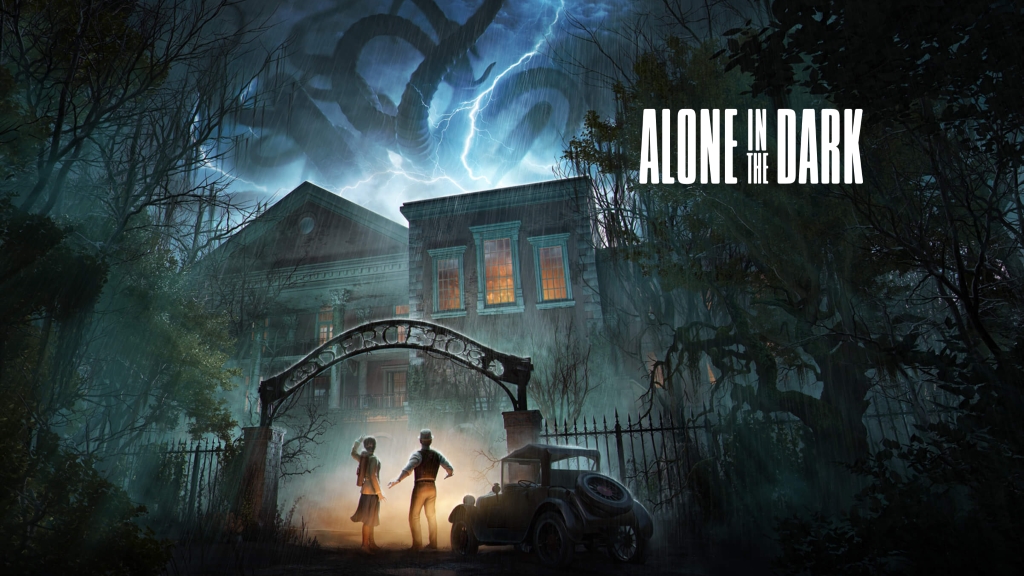
When it comes to reimagining horror classics, we’ve been getting quite a few of these titles announced or released, pretty much since the Resident Evil 2 remake kicked off this trend back in 2019. I couldn’t have imagined the day when we’d actually see yet another take of Alone In The Dark, the 3D horror title that started it all back in 1992. But that day is now upon us, and I’ve spent a lot of time in the reimagined Derceto Manor over the last week.
After getting to play the original Alone In The Dark in 1995, my world was changed, since it helped me to see the expansive potential of 3D-rendered adventure games. I’ve never looked back since. I spent weeks of my life figuring out how to finish the game in a time before online guides were around; getting immersed in Derceto and its mysteries from top to bottom, so when the announcement came in 2022 that there’d be a remake, my excitement was piqued.
There was a canceled attempt at a remake of the first AitD game back in the early 2010s, which was set to use fixed camera angles like the original game. However, this new iteration for 2024 chose to have the game feature the popular over-the-shoulder gameplay style that’s been featured in so many horror games in the last five years or so.
Despite following the recent trend of this camera style, I still had faith that the game would manage to set itself apart from the current crowd in some important ways. As such, I was excited to find out if it would have a level of uniqueness and authenticity the original game had when I got the chance to finally experience it for myself.
Since this is the first game to bear the Alone In The Dark name in nearly a decade (the poorly recieved Illumination being the last entry), it feels like a lot is resting on its shoulders, so let’s assess how it all comes together.

Story
For long-time fans, I don’t think much needs to be said about the premise and setup of the story, since it’s been the same since 1992. Emily Hartwood and the private investigator she hired, Edward Carnby, arrive at Derceto Manor, a large house in the swamplands near New Orleans, looking to investigate her uncle, Jeremy, who lived at the manor.
Even if you know the story of the original game, you’ll start to notice right from the start that many things have changed, and as things progress, you’ll realize that almost nothing besides the basic premise is retained for this reimagining at all.
In the original, Jeremy was said to have committed suicide, and was the sole caretaker of the manor, but 2024’s AitD takes a very different approach, choosing to make Derceto an asylum with many different patients, with Jeremy just being one of them. Also, he hasn’t died, but has gone missing after sending a strange and cryptic letter to Emily, his niece.
This change already opens it up to be a very different experience, which ends up including a fairly large cast of characters instead of your protagonist being the sole living body within the mansion, changing the tone of the game entirely. The feeling of isolation that made the original such an intense and frightening experience is replaced with what ends up more akin to a noir murder mystery story with a large cast of potential suspects, all with their own stories and truths to discover.
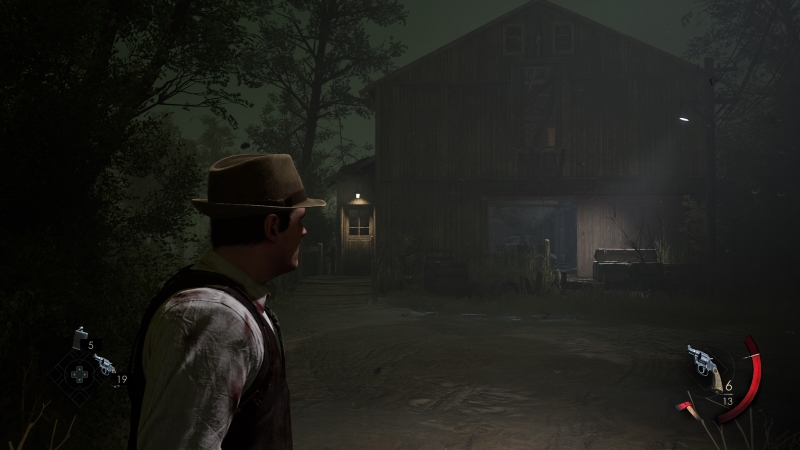
Filling out the rest of the cast are the caretakers and doctors of the asylum, as well as the other residents and patients of the mansion, which oddly includes Grace Saunders, the young girl who was featured in the original Alone In The Dark 2. However this time, she plays a completely different role and is a bit of an anachronism to the timeline of the original series here.
Grace even got her own playable prologue chapter – free to download – that takes place shortly before the main story, and is recommended to play first just to get a little extra context for the story, as well as serving as a teaser for the main game.
Soon after starting your exploration of the mansion, you’ll begin to meet more of these characters, and you’ll be mysteriously transported to new and strange locations outside of Derceto, which leads to another element of the new presentation here.
If looking at the bigger picture, only about half of the game actually takes place within Derceto itself. The other half takes place in wildly different locations, which manifest as mental spaces of the various characters, mostly Jeremy, Edward, and Emily.
Again, straying from the original feeling of isolation and entrapment that the original game offered, this one has you venturing into lands and scenarios far from Derceto, and it tends to cause a feeling of whiplash with the frequent transitions between the two halves of the game. This frequent and sudden switching of environments also has a positive effect, in that it keeps you feeling somewhat disoriented, which can be a powerful tool in horror games, creating uneasiness.
As the story progresses, you’ll begin to notice that much of the Lovecraft-inspired elements from the original story are less present here, and even though one of the main underlying plot elements is still very much in this realm, most of it doesn’t really come forward in the game until right near the end.
This Alone in the Dark dives much deeper into Southern Gothic horror and Cajun mysticism on its surface, much more than the original 1992 release. This does give it a unique feel and tone of its own, even if it strays from the source material. This Southern Gothic tone also carries into many little details and touches in the design of the world, including the language and accents used, which are mostly accurate to the time and place AitD is set in, as well as many of the other details in the game’s UI and overall text.
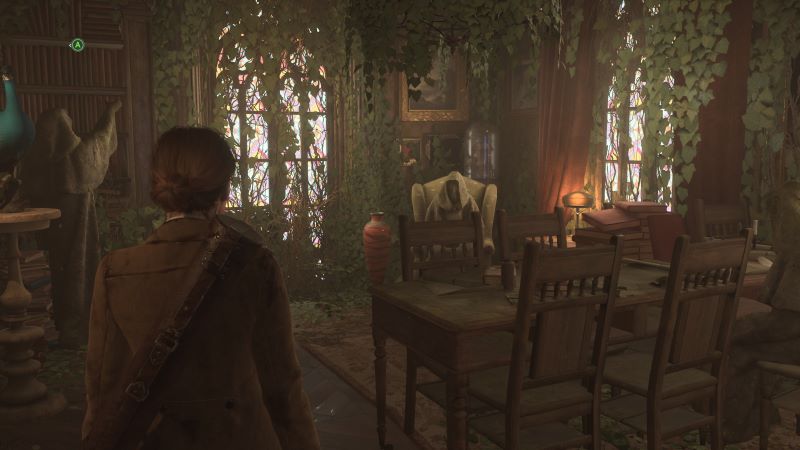
Emily and Edward
Since the game lets you choose whether to play as Emily or Edward, it’s important to mention that your choice of character will affect the story greatly at a certain point towards the end. However, for the most part, the other 85% of the game will progress nearly identically. There’s also a few other cutscenes throughout the game that will occur at different times for each character, but still contain largely the same dialogue.
Each character has about 60-90 minutes of gameplay that’s unique to them during this section, and both are very different from each other, as well as being important to understanding the full scope of the story. Having said that, it feels like having more unique scenes for each character could’ve gone a long way towards replay value and depth to the story in general.
On the side of the voice acting, it’s generally very well done across the board, with Emily (played by Jodie Comer) being a standout here, where her voice and motion capture performance gives an emotional depth to the character throughout, which really helps her story sink in a little bit more.
Unfortunately, I can’t say that David Harbour‘s performance as Carnby does any favors for the character, as most of his lines feel flat, phoned-in, and unemotional as a whole. Also, his dialogue tends to clash with the overall setting and tone of the other characters. The supporting cast all feel like great character actors who do their part well and create memorable moments with just a few scattered lines of dialogue throughout, making them fit right in with the weird world of AitD.
Without spoiling too much, the story starts to feel less comprehensible and more disjointed as it progresses, and becomes a fairly trope-filled exploration of mental illness without a lot of nuance or depth overall. This leads to a fairly anti-climatic ending that doesn’t feel very worth the journey from a narrative angle. The narrative in general feels like it tried hard to have a deeper, more esoteric exploration of its themes, but never really gave enough information or context to get there, though not for lack of trying.
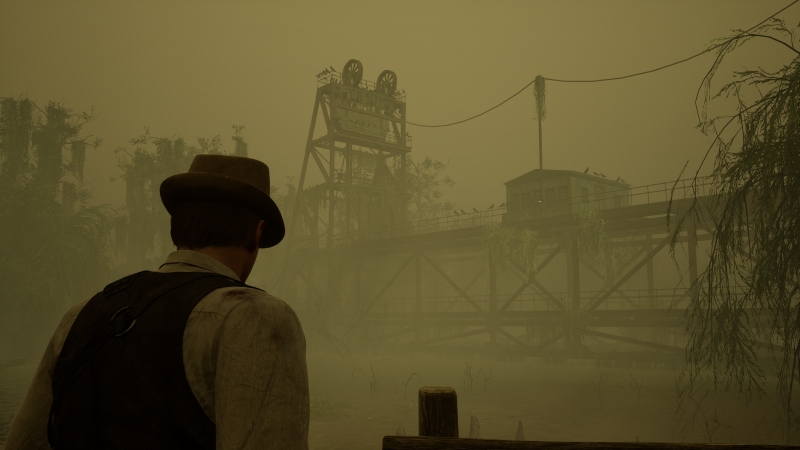
Gameplay
While the story may be disappointing overall, that doesn’t mean the rest of the game is nearly as much of a let-down, since we can now move on to the mechanics and systems of the gameplay, where things get a whole lot better.
As previously mentioned, Alone in the Dark game feels split between two different kinds of gameplay sections, with the ones that take place within Derceto and the ones that take place outside feeling like two distinct styles. Because of this, it also becomes clear fairly early on that whenever you’re within the walls of Derceto, there will be no combat, as threats and combat typically only occur when traveling through the outside sequences, outside of a few small exceptions.
While this does lead to another positive aspect of the game, since it allows much more focus on exploration and puzzle solving throughout Derceto, it also takes away a little bit of the tension knowing that there are no threats prowling around the manor as you explore. There’s still plenty of ambiance and strange noises or events that occur during the manor sections, but you soon realize you’re never really in any danger.
The puzzles and navigation within the mansion are some of the best parts of the game. Even though they start to follow some similar patterns for the most part, they will give your brain a little more workout than something like the ones in the Resident Evil remakes, and it always feels satisfying to finally piece one of them together. The game frequently requires you to keenly observe small details in your environment, as well as consult old clues or documents you will have picked up long before the puzzle, which adds another layer of mindfulness.
Regarding the puzzles themselves, the game provides options to fine tune to your preference in the options menu. Here you can choose to get extra hints or tutorials on how to solve something, or just choose the “Old School” feature, leaving off all extra hints and tips. The modern assistance mode also gives options for actively marking your map with clues and navigation hints (similar to the Silent Hill games). These customization options go further than just the puzzles, extending to all aspects of the gameplay, and they’re a nice touch that allow players to choose their experience.
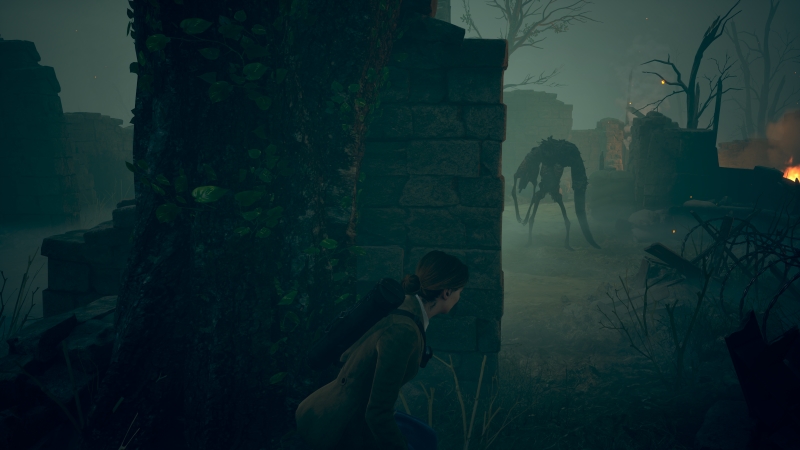
There is still some exploration and puzzle solving within the “outside Derceto” sequences as well, but they’re interspersed with combat encounters, which is nice as a means of breaking up the flow and let the game’s combat mechanics shine for short periods of time. As far as the combat in Alone In The Dark, it’s probably useful to have a disclaimer here that the game features very little for its entire run, choosing to focus on story, puzzle solving, and exploration instead.
Essentially, if you’re expecting a hyper-cinematic and action-packed game similar to the recent remakes of Resident Evil or Dead Space, you’ll likely be disappointed by this experience. Alone In The Dark is a much more meticulous and moody experience overall, kind of like the original game, which similarly only features a small handful of enemies throughout its entire length.
That said, when the combat does get to shine, it’s satisfying, even if brief and infrequent, since there’s a lot of different mechanics that make up the options to deal with enemies. These include: shooting, using environmental objects as weapons, melee combat, and even stealth mechanics that let you choose how to approach each encounter. As you’d imagine, in a survival horror game, the resources available to you are relatively scarce and you can’t withstand much damage from enemies before dropping dead. However, resources never feel oppressively scarce overall, even when playing on the highest difficulty, though it can get very close.
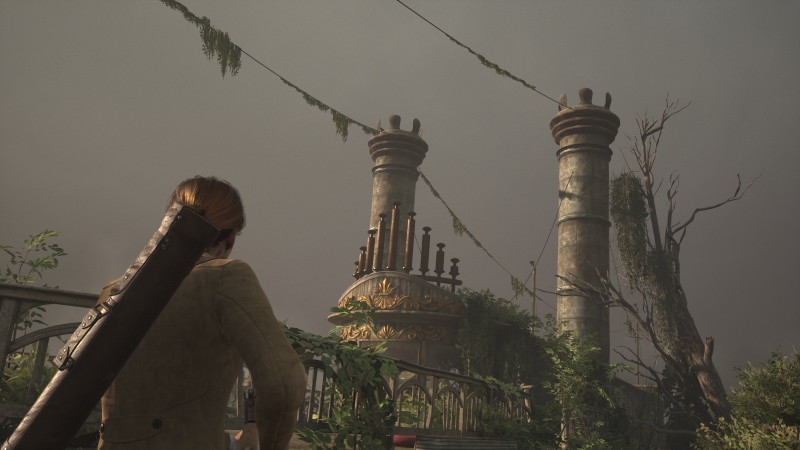
Despite the resources never feeling too rare, every enemy encounter is still very tense due to the terrifying enemy designs, the sound design, and some of the combat mechanics, which all work together to make each encounter feel like a fight for survival. The fact that some of the encounters happen in small, cramped spaces and corridors makes many of them extra tense, and enemies move pretty quickly, so things will happen fast once combat starts.
These mechanics all come together to strike a sort of balance, though it never feels fully balanced, since the dodge mechanic allows you to avoid most damage with a simple button press, and every encounter has a large number of throwable environmental objects to use for combat, with some being much more useful than others. However, the purposeful clumsiness of the shooting mechanics and the easily breakable melee weapons (much like in the original) do even things out a bit, making for a constant seesaw of attempted balancing during fights.
Outside the normal combat mechanics, as mentioned before, there’s also a stealth system that allows you to completely avoid some enemy encounters, or just get a surprise attack for a little extra damage. You can also use some of the throwable environmental items to distract enemies, or throw them off their usual movement path in order to sneak by unnoticed, which is a nice option when stealth is available. The stealth mechanics feel satisfying to use and can be quite useful, though the small amount of enemies that you encounter throughout the game overall makes it feel slightly underused.
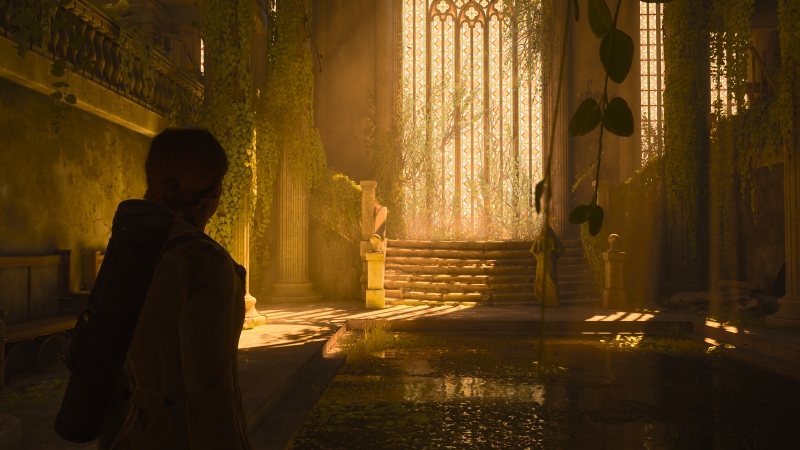
Visuals
As far as the visual and design side, this is one of the strongest points of Alone in the Dark 2024. The world and everything in it feels precisely and thoughtfully designed, nailing its Southern Gothic aesthetic and influence. The haunting, rustic look of Derceto feels old and lived-in, and everywhere you look, there are little details scattered throughout that tell a story of a character or of the house itself. All the areas are oozing with ambience that inspires uneasiness in a way that many similar modern games weren’t able to achieve.
The external areas all have very distinct and striking visuals to them as well, ranging from the swamps and oil fields of Louisiana, an ancient desert temple, a World War I battlefield, the streets of the French Quarter, a bayou cemetery, and more. Each has its own unique tone and character and is packed with tiny details and visual splendor in every corner that make your journey feel more epic, even if they don’t always tie into the story in profound ways.
There are also little Easter eggs thrown in that reference other events or characters within the original Alone In The Dark universe, and even a complete visual throwback to the fixed-camera style of the series in one scene near the end of the game, just thrown in for fans who are paying attention. The only thing that sometimes breaks this rule of tonal and visual harmony is Carnby himself, whose clothing, face, and voice acting tend to break the immersion a tiny bit, and generally just feel out of place.
Regardless of the very impressive results achieved on the visual side, it’s also clear that the game is not the kind of insanely polished, over-the-top AAAA budget title that recent Resident Evil titles or Alan Wake 2 are. Those looking for that kind of technological marvel won’t find it here. Tempering expectations and understanding that this is a game that had a much smaller team and budget, you’ll find the game still has plenty of its own technical achievements and charm.
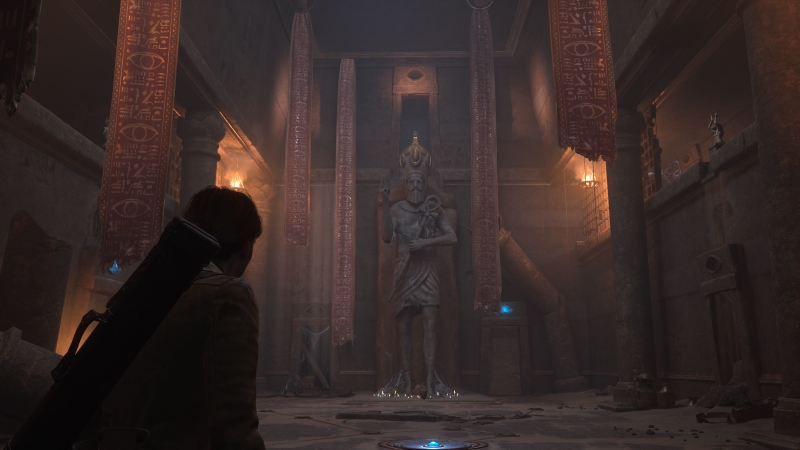
In regards to the how it runs and the controls, the game ran well across the board on the Xbox Series X it was played on, whether it was on Performance mode or Quality mode. There were a few small audio bugs and some movement or collision glitches here and there, but nothing that broke the game, and much of this will likely be patched soon.
In terms of the controls, everything worked very well for the most part, and there’s plenty of options to customize your control experience in the menus, so most people will find a setting that works for your play style. The turning and movement mechanics can occasionally have a slight clunkiness to them every once in a while, but it’s not too often and not much of a bother even when it does happen.
The play length is between 12-15 hours if you don’t rush through it, and there are tons of collectibles and extras to find if you want to take your time. As long as you’re watching all the cutscenes, the game will be at least eight hours long, though it tends to feel relatively speedy while playing. Since you need to play through as both characters to get the full experience, this makes it longer than most of the recent over-the-shoulder horror games.
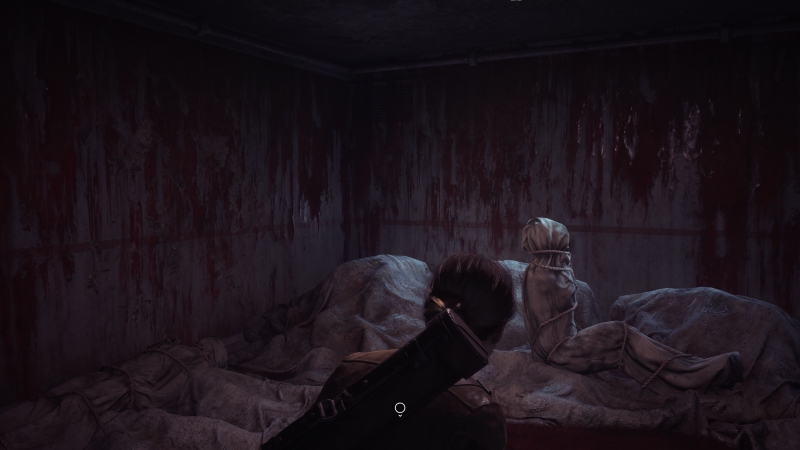
Conclusion
To summarize: Alone In The Dark has a palpable feeling of trying to balance a lot of things at once, and struggling with some, while getting it right on others. This leads to an experience that’s enjoyable while you’re playing it, but starts to feel a bit lacking once you put down the controller and try to analyze it further. This doesn’t mean it’s a bad game by any means, just one that’s a little confused and doesn’t quite reach the heights of some other recent horror gaming experiences, where the bar has been raised extremely high in the last few years.
This new reimagining of an influential survival horror title shows a lot of love for the original in some small ways, but also disregards and tramples over much of its DNA, so some hardcore fans may be disappointed if looking for a 1:1 remake.
At the end of the day, Alone In The Dark is an enjoyable retelling of a horror classic that aimed high and only partially stuck the landing with its story. However, it’s still a fun experience for those looking for a new non-action survival horror game in 2024 and is a nice alternative to the action-packed, over-the-shoulder titles of the last few years.
 (8 / 10)
(8 / 10)
Great
 (8 / 10)
(8 / 10)Rely on Horror Review Score Guide
A review code was provided by the publisher for Xbox Series X.

 IDOLxISxDEAD
IDOLxISxDEAD


